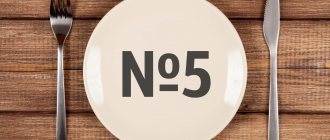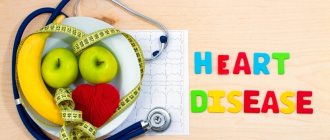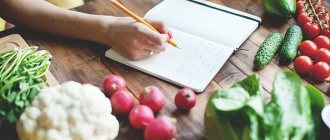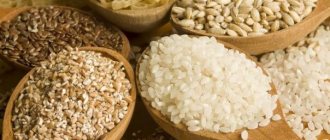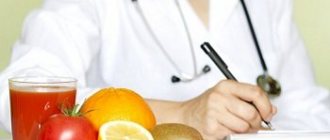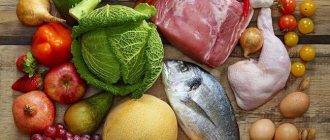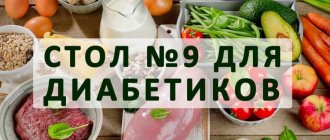11/25/2019 Article
- general characteristics
- Table "Do's and Don'ts"
- Menu for the week
- Diet modifications Diet “Table 4A”
- Diet "Table 4B"
- Diet "Table 4B"
- Diet for children
The “4 table” diet is indicated for acute intestinal diseases and exacerbations during the period of ongoing diarrhea. The goal of the diet is to provide the body with the necessary nutrients without irritating the intestines or causing fermentation in it. “Table 4” refers to strict medical diets; it is prescribed during periods of exacerbation of dyspeptic disorders, chronic intestinal diseases and after operations.
Medicines at affordable prices. A large assortment. Order now!
Antidiarrheal drugs
General rules
Let's figure out what a therapeutic diet is.
Nutritional therapy is prescribed for various diseases and is a mandatory method of therapy. In some cases, this is the only or primary method of treatment. The founder of dietetics M.I. Pevzner, who developed the basics of therapeutic nutrition, wrote that in its absence there is no rational treatment. For each disease, a specific table is assigned. Thus, Table No. 4 (Diet No. 4 according to Pevzner) is prescribed for intestinal diseases that occur with diarrhea . The purpose of its administration in this condition is to reduce inflammation, fermentation and putrefactive processes that predominate in this case. It protects the intestines and helps normalize digestion.
Due to the reduction of fats (up to 70 g) and carbohydrates (250 g), it has a reduced energy value. Daily calorie content is 2000 kcal. At the same time, the normal protein content (90 g) is maintained. All kinds of intestinal irritants are significantly limited: mechanical, chemical and thermal.
Products that enhance secretion, fermentation and putrefaction processes, stimulants of bile secretion, secretion of gastric juice and pancreas are excluded. Dishes are boiled or steamed, served in a liquid, semi-liquid or mashed state. Very hot and cold foods are excluded. Salt is allowed in the amount of 8-10 g, the water regime is 1.5-2 liters per day. Meals are provided up to 5-6 times a day, in fractional portions and warm.
The basic rules are:
- six meals a day, the basis of which are mashed, pureed, mushy dishes, slimy soups;
- boiled and steam cooking methods;
- Hard, thick, hot and cold foods are prohibited.
A nutritious diet is possible
The basic principle of a diet for intestinal diseases is the most complete diet with sufficient calorie content. Impaired digestion of food leads to a person sharply losing weight not only due to fat reserves, but also due to muscle mass. Therefore, the amount of complete protein in the menu should be increased to 130-140 g
and higher. It is also necessary to make meals in fractions: five to six meals a day can reduce the load on the digestive tract and improve the absorption of nutrients.
Varieties
The varieties are Diets 4A , 4B , 4B , which have differences in the set of permitted products and other indications for use. Thus, table 4B is prescribed during a period of improvement or during mild exacerbation of chronic intestinal diseases. Contains more proteins (100-110 g), fats (100 g) and carbohydrates (400-420 g). Has high energy intensity (up to 3000 kcal). The diet remains the same, but the list of permitted foods has been expanded: vermicelli, noodles, carrots, potatoes, cauliflower, zucchini, cream, sour cream, kefir, sweet berries and fruits.
Table 4B is indicated during the period of recovery and transition to normal nutrition. Contains the same amount of proteins, fats (vegetables are already included) and carbohydrates. The list of permitted products has been significantly expanded: buns, pies, cabbage, green peas, beets, doctor's sausage, dairy, ham, oranges, grapes, tangerines, strawberries, watermelon, raspberries, vegetable oil, and the amount of butter has been increased to 15 g per dish.
Diet modifications
In addition to the main diet, there are several variations.
Diet "Table 4A"
Diet “Table 4A” is a diet prescribed for celiac disease, steatorrhea, colitis with the presence of fermentation processes. It is distinguished by a higher amount of protein and calcium contained, the exclusion from the diet of cereal products (bread, cereals, flour products) and products that have a negative effect on liver function.
Diet "Table 4B"
The “Table 4B” diet is prescribed for:
- not a sharp exacerbation of intestinal diseases (colitis, enterocolitis),
- during the period of oncoming recovery in acute form of enterocolitis,
- when accompanied by the listed conditions with diseases of the pancreas, biliary tract, liver and stomach.
The diet is similar to the main diet, but allows the use of:
- dry biscuits, savory buns and pies;
- black caviar, boiled pasta, mild cheeses;
- boiled pureed vegetables: zucchini, zucchini, pumpkin, cauliflower and fresh tomatoes;
- marshmallows, marshmallows, marmalade, jam;
- aromatic herbs: dill and parsley;
- seasonings: bay leaf, vanilla, cinnamon;
- fruits: strawberries, pears, tangerines and apples.
After the “Table 4B” diet, they move on to “Table 4B” or to a regular diet.
Diet "Table 4B"
The “Table 4B” diet is a special diet prescribed during the period of remission and recovery for chronic or acute forms of enterocolitis, infectious and other intestinal diseases. A characteristic feature of the diet: eating food in a non-chopped state, limiting fried foods.
The list of consumed products is expanding: buns with cottage cheese, doctor's or milk sausage, sausages, soaked herring, kefir, fermented baked milk, refined vegetable oil, ripe fruits, beets, tomato juice, compotes.
Diet for children
The “4 table” diet for children is used in case of exacerbation of intestinal diseases in children. It is distinguished by the consumption of large quantities of mineral water, herbal teas, and compotes. Otherwise, the same recommendations apply as for adults.
See also:
- Sanatoriums with gastrointestinal treatment
- Diet “1 table” for gastritis, gastric ulcer and intestinal ulcer
- Diet “2 table” for gastritis
- Diet "3 table" for constipation
- Diet “5 table” for diseases of the liver, biliary tract and gall bladder
- Diet “15 table” for diseases that do not require special therapeutic diets
Save the link:
Authorized Products
Dietary food at this table involves the use of dried wheat bread or crackers. You can eat 200 g of thinly sliced and not very fried crackers per day. Unsweetened dry cookies are allowed.
Porridge is the main product
The basis of the diet is pureed porridge from semolina, rice (white rice), buckwheat and oatmeal, which are prepared in water or broth (low-fat). Butter is added in the amount of 5 g per serving, per day - 50 g.
Soups are also prepared with low-fat and non-rich fish or meat broth, adding permitted cereals, a minimum of vegetables, boiled and pureed meat, quenelles, egg flakes, meatballs, etc.
The fourth table involves the consumption of lean and lean varieties of beef, chicken, turkey, veal, and rabbits. To do this, the meat is additionally degreased, and the tendons and skin of the bird are removed.
Steam cutlets, soufflé or meatballs are prepared. They can also be stewed in a saucepan over water. When preparing cutlets, boiled rice or semolina is placed in the minced meat instead of bread. You can make pate from boiled meat with a minimum of salt.
Low-fat varieties of fish are prepared in pieces or chopped in the form of quenelles, cutlets and meatballs. They can also be cooked by steaming or in water. 1-2 eggs per day are allowed, which are cooked soft-boiled or steamed omelettes, added to soufflés and soups.
As for cottage cheese, it should be unleavened (non-acidic) and mashed; you can use it to make steamed soufflés and casseroles. Vegetables are eaten only as a pureed addition to soups and in small quantities.
Mashed raw apples, applesauce, berry jelly from blueberries, dogwood, quince, bird cherry, pears and fruit drinks are allowed. If well tolerated, you can drink diluted fresh juices from non-acidic berries (diluted 1:1 with water). The exceptions are grape, apricot and plum juices. Herbal tea, rosehip decoction, bird cherry infusion, dried dogwood, blueberries, green and black tea, still water up to 1.5 liters per day are allowed.
Table of permitted products
| Proteins, g | Fats, g | Carbohydrates, g | Calories, kcal | |
Fruits | ||||
| quince | 0,6 | 0,5 | 9,8 | 40 |
| pears | 0,4 | 0,3 | 10,9 | 42 |
| apples | 0,4 | 0,4 | 9,8 | 47 |
Nuts and dried fruits | ||||
| dried pears | 2,3 | 0,6 | 62,6 | 249 |
Cereals and porridges | ||||
| buckwheat (kernel) | 12,6 | 3,3 | 62,1 | 313 |
| semolina | 10,3 | 1,0 | 73,3 | 328 |
| oat groats | 12,3 | 6,1 | 59,5 | 342 |
| cereals | 11,9 | 7,2 | 69,3 | 366 |
| white rice | 6,7 | 0,7 | 78,9 | 344 |
Bakery products | ||||
| white bread crackers | 11,2 | 1,4 | 72,2 | 331 |
Confectionery | ||||
| Maria cookies | 8,7 | 8,8 | 70,9 | 400 |
Dairy | ||||
| skim milk | 2,0 | 0,1 | 4,8 | 31 |
| acidophilus | 2,8 | 3,2 | 3,8 | 57 |
Cheeses and cottage cheese | ||||
| cottage cheese 0.6% (low fat) | 18,0 | 0,6 | 1,8 | 88 |
Meat products | ||||
| boiled beef | 25,8 | 16,8 | 0,0 | 254 |
| boiled veal | 30,7 | 0,9 | 0,0 | 131 |
| rabbit | 21,0 | 8,0 | 0,0 | 156 |
Bird | ||||
| boiled chicken | 25,2 | 7,4 | 0,0 | 170 |
| turkey | 19,2 | 0,7 | 0,0 | 84 |
Oils and fats | ||||
| butter | 0,5 | 82,5 | 0,8 | 748 |
Non-alcoholic drinks | ||||
| mineral water | 0,0 | 0,0 | 0,0 | — |
| green tea | 0,0 | 0,0 | 0,0 | — |
| black tea | 20,0 | 5,1 | 6,9 | 152 |
| * data is per 100 g of product | ||||
Minerals from dairy products
Dairy products will help replenish mineral deficiencies. The protein and fat in them are absorbed with minimal stress on the digestive organs, and there is enough phosphorus and calcium to maintain the balance of these substances in the body at a normal level. Fresh milk and fermented milk products are sometimes very poorly tolerated for intestinal diseases, but unleavened cottage cheese
and low-fat and unsalted cheese are digested normally.
Therefore, in case of intestinal diseases, nutritionists recommend giving up even the most “healthy and natural” kefir or yogurt and choosing freshly prepared and well-squeezed cottage cheese and mild varieties of cheese
.
Fully or partially limited products
Diet number 4 for the intestines is based on the exclusion of foods containing fiber. In this regard, vegetables are excluded (can be decoctions or added to soup), bran, whole grain, rye and bran bread with the addition of seeds and cereals, which additionally injure the intestinal mucosa and are poorly digested.
Fresh bread, pastries, pancakes and pancakes cause fermentation and rotting in the intestines and are therefore prohibited. For the same reason, jam, dried fruits, honey, jams and other sweets are not allowed, and sugar is allowed in a limited amount of 50 g per day (in all dishes).
Porridges made from millet, barley, pearl barley, legumes and pasta are coarse and poorly digestible foods that must be excluded during the period of exacerbation of the disease.
Rich fatty broths that enhance intestinal motility, fatty meats, sausages, fatty fish, canned food and salted fish are also prohibited.
Whole milk, sour cream, cream and cheese can cause increased diarrhea . Milk is used only in diluted form when preparing porridges and puddings.
Cocoa and coffee with milk, kvass, carbonated drinks that increase intestinal motility and bloating are unacceptable for these diseases. You cannot eat sauces and marinades, smoked meats, sausages, or ham.
Table of prohibited products
| Proteins, g | Fats, g | Carbohydrates, g | Calories, kcal | |
Vegetables and greens | ||||
| vegetables | 2,5 | 0,3 | 7,0 | 35 |
| vegetables legumes | 9,1 | 1,6 | 27,0 | 168 |
| potato | 2,0 | 0,4 | 18,1 | 80 |
| horseradish | 3,2 | 0,4 | 10,5 | 56 |
Fruits | ||||
| bananas | 1,5 | 0,2 | 21,8 | 95 |
| melon | 0,6 | 0,3 | 7,4 | 33 |
Berries | ||||
| grape | 0,6 | 0,2 | 16,8 | 65 |
Mushrooms | ||||
| mushrooms | 3,5 | 2,0 | 2,5 | 30 |
Nuts and dried fruits | ||||
| dried fruits | 2,3 | 0,6 | 68,2 | 286 |
Cereals and porridges | ||||
| pearl barley | 9,3 | 1,1 | 73,7 | 320 |
| Wheat groats | 11,5 | 1,3 | 62,0 | 316 |
| millet cereal | 11,5 | 3,3 | 69,3 | 348 |
| barley grits | 10,4 | 1,3 | 66,3 | 324 |
Flour and pasta | ||||
| pasta | 10,4 | 1,1 | 69,7 | 337 |
Confectionery | ||||
| jam | 0,3 | 0,2 | 63,0 | 263 |
| jam | 0,3 | 0,1 | 56,0 | 238 |
| candies | 4,3 | 19,8 | 67,5 | 453 |
| cookie | 7,5 | 11,8 | 74,9 | 417 |
Ice cream | ||||
| ice cream | 3,7 | 6,9 | 22,1 | 189 |
Cakes | ||||
| cake | 4,4 | 23,4 | 45,2 | 407 |
Raw materials and seasonings | ||||
| seasonings | 7,0 | 1,9 | 26,0 | 149 |
| mustard | 5,7 | 6,4 | 22,0 | 162 |
Dairy | ||||
| kefir | 3,4 | 2,0 | 4,7 | 51 |
| sour cream | 2,8 | 20,0 | 3,2 | 206 |
Cheeses and cottage cheese | ||||
| cheese | 24,1 | 29,5 | 0,3 | 363 |
Meat products | ||||
| pork | 16,0 | 21,6 | 0,0 | 259 |
| ham | 22,6 | 20,9 | 0,0 | 279 |
Sausages | ||||
| boiled sausage | 13,7 | 22,8 | 0,0 | 260 |
| dry-cured sausage | 24,1 | 38,3 | 1,0 | 455 |
| sausages | 10,1 | 31,6 | 1,9 | 332 |
| sausages | 12,3 | 25,3 | 0,0 | 277 |
Bird | ||||
| duck | 16,5 | 61,2 | 0,0 | 346 |
| goose | 16,1 | 33,3 | 0,0 | 364 |
Fish and seafood | ||||
| dried fish | 17,5 | 4,6 | 0,0 | 139 |
| smoked fish | 26,8 | 9,9 | 0,0 | 196 |
| canned fish | 17,5 | 2,0 | 0,0 | 88 |
Oils and fats | ||||
| vegetable oil | 0,0 | 99,0 | 0,0 | 899 |
| animal fat | 0,0 | 99,7 | 0,0 | 897 |
| cooking fat | 0,0 | 99,7 | 0,0 | 897 |
Non-alcoholic drinks | ||||
| bread kvass | 0,2 | 0,0 | 5,2 | 27 |
Juices and compotes | ||||
| juice | 0,3 | 0,1 | 9,2 | 40 |
| * data is per 100 g of product | ||||
Menu (Power Mode)
It is necessary to organize 6 meals a day and so that the 4th table for the week includes alternating a variety of protein dishes (beef, chicken, fish, rabbit, turkey, cottage cheese) and cereals, and egg dishes daily.
Below is an approximate menu for week of diet No. 4, which can be modified at will, however, the basic principles regarding the set of permitted foods and their heat treatment remain unchanged.
Monday
| Breakfast |
|
| Lunch |
|
| Dinner |
|
| Afternoon snack |
|
| Dinner |
|
| For the night |
|
Tuesday
| Breakfast |
|
| Lunch |
|
| Dinner |
|
| Afternoon snack |
|
| Dinner |
|
| For the night |
|
Wednesday
| Breakfast |
|
| Lunch |
|
| Dinner |
|
| Afternoon snack |
|
| Dinner |
|
| For the night |
|
Thursday
| Breakfast |
|
| Lunch |
|
| Dinner |
|
| Afternoon snack |
|
| Dinner |
|
| For the night |
|
Friday
| Breakfast |
|
| Lunch |
|
| Dinner |
|
| Afternoon snack |
|
| Dinner |
|
| For the night |
|
Saturday
| Breakfast |
|
| Lunch |
|
| Dinner |
|
| Afternoon snack |
|
| Dinner |
|
| For the night |
|
Sunday
| Breakfast |
|
| Lunch |
|
| Dinner |
|
| Afternoon snack |
|
| Dinner |
|
| For the night |
|
Features of diet No. 3 for constipation
The weekly dietary menu is designed taking into account the balance of proteins and carbohydrates in the diet. At the same time, there is an increase in the amount of fat due to the inclusion of vegetable oils. The diet involves consuming 100–120 g of fat, 85–100 g of protein, 450–500 g of carbohydrates.
Table No. 3 does not provide for the obligatory chopping or grinding of food. It is allowed to consume boiled and baked dishes, as well as carbonated mineral water in moderate quantities. You can cook porridge with milk diluted with water in a 1:1 ratio.
Drinks and foods whose temperature is below 15 °C increase peristalsis and reduce the production of gastric juice. Therefore, for constipation, it is recommended to drink chilled drinks. Before breakfast, it is advisable to drink a glass of cold water, and at night - compote or kefir. In addition, to soften the stool, it is useful to take 1-2 tablespoons of unrefined vegetable oil on an empty stomach. The oil coats the intestines and improves the movement of feces.
You can follow the diet for a long time. With this diet, the frequency and consistency of stools are normalized. This diet is indicated for constipation caused by an unbalanced diet and a sedentary lifestyle.
Prohibited Products
Like other diets, “Table No. 3” involves excluding certain foods from the diet. These include:
- flour products from yeast and puff pastry;
- fatty fish and meat, strong meat broths;
- radish, horseradish, garlic and other spicy vegetables;
- spicy sauces, mustard, hot pepper;
- strong tea, coffee and other caffeinated drinks;
- canned foods, fried eggs;
- legumes, mushrooms (mushroom broths are allowed);
- bananas, dogwood, blueberries, nuts;
- drinks with tannins: jelly, cocoa, drinks made from quince, bird cherry and blueberry.
Whole milk, smoked meats, fried and pickled foods are not recommended. You also need to exclude alcoholic drinks, chocolate, pasta, and legumes. Prohibited foods include rice, semolina, sweets with cream, and margarine. There is no need to eat foods that are difficult to digest: mashed potatoes, canned food, hard-boiled eggs, slimy soups.
Get rid of intestinal problems
The natural British drug is not addictive and works immediately
Find Fitomucil with benefits
Diet 4th table recipes for the week
Here are some recipes.
Pike perch meatballs
Ingredients : 50 g water, 50 g rice, 15 g butter, salt, 300 g pike perch fillet.
Pike perch meatballs
Cooking steps . Cook a sticky porridge of white rice. Pass it together with the pike perch pulp through a meat grinder (preferably twice), add melted butter, a little salt and water. Beat the minced meat well and form into meatballs. Cook in a steamer or any device for steaming dishes.
Steamed hake fillet balls
Ingredients : one egg, 300 g hake fillet, 50 g semolina, salt.
Cooking steps . Pass the fillet through a meat grinder, add semolina (no need to boil it), salt, egg, mix and beat thoroughly. Cook the chopped meatballs in a double boiler.
Steamed beef cutlets
Ingredients : 700 g beef, 1 pc. onions, 2 chicken eggs, rice flour 100 g, salt.
Cooking steps . Pass the meat and onions through a meat grinder. Add egg, salt and rice flour. Knead the minced meat well and put it in the refrigerator for an hour. Form cutlets and place them in a steamer, having previously greased the bottom and walls with vegetable oil. Cook for 30 minutes.
Steam omelette
Ingredients : 2 chicken eggs, salt, 1.25 glasses of milk.
Steamed omelette
Cooking steps . Beat the eggs well with milk, add salt. Place a small container with the egg mixture in the multicooker bowl, greasing it with butter (vegetable) oil. Cook the omelette in the “steam” mode. If you don’t have a multicooker or a double boiler, you can organize a water bath: pour water into a saucepan with a thick bottom and place a container (glass or metal) with the egg mixture in it. Grease the omelette pan with oil and it is important that the bottom just touches the surface of the water. Cook over low heat for 35 minutes with the lid closed.
Buckwheat pudding with cottage cheese
Ingredients : 0.25 cups buckwheat, 150 g low-fat cottage cheese, one egg, 1 tsp sugar.
Buckwheat pudding with cottage cheese
Cooking steps . Prepare buckwheat porridge and puree it. Combine with cottage cheese, add yolk and sugar, mix thoroughly and lastly add well-beaten egg white. Place in a pan greased with butter and steam. Drizzle with melted butter.
Puree buckwheat porridge
Ingredients : 0.5 cups buckwheat, 2 cups water, salt, sugar 1 tsp, butter 5g.
Cooking steps . Prepare buckwheat porridge using more water than for preparing crumbly porridge. Boil with salt and rub it. Add sugar and butter to the finished dish.
Therapeutic diet 4th table for children
Used in the presence of diarrhea . On the first day, a fasting diet - the child is given only herbal teas and decoctions , and still Borjomi mineral water. The daily amount of liquid is no more than 1 liter, drink is given in fractions, often and in small portions, so as not to provoke vomiting. On the second day, they are transferred to this diet with meals at least 6 times a day.
The diet is no different from that of adults. The child is first given mucous infusions of rice, low-fat, non-cool chicken and beef broth, soups with the addition of oatmeal, semolina, and steamed fish and meat dishes. Ground meat or meatballs are added to soups. If the child eats porridge well, then pureed buckwheat, rice and oatmeal are prepared.
A steam omelet is prepared from eggs; a child can eat cottage cheese in its natural form or as steamed casseroles. Butter is used exclusively for dressing. Decoctions of blueberries, rose hips, quince and jelly are suitable drinks for children. During the day you can give crackers made from wheat bread.
Butter dough, vegetable and milk soups, smoked meats, canned food, sausages, and fatty meats are prohibited. You should not give your child sour cream, milk, vegetables of any kind, carbonated drinks, fresh fruit and grape juice.
After 6 days of dietary nutrition, the child, if necessary, is transferred to a more expanded Diet No. 4B. It allows some vegetables (zucchini, cauliflower, pumpkin, potatoes, carrots), which are added to soups, as well as small noodles. Porridge is prepared with a small amount of milk. It is allowed to add sour cream to dishes in small quantities.
Recommendations
In order to correctly follow table number 4, you need to know some of the nuances of preparing dishes and consuming a number of products:
- Cook soups only with low-fat, non-concentrated broth. If possible, they should be slimy and not thick.
- Porridge - ground. Cook mainly in water, with the addition of a small amount of milk.
- Remove all fat layers, tendons, skin and fascia from meat and fish. You cannot serve it in pieces - only minced through a meat grinder, which must have a minimum hole diameter.
- Allowed vegetables are only after heat treatment. Preferably in soups. In limited quantities.
- Milk cannot be drunk separately, only when added to dishes (porridge, omelettes, puddings).
- Non-carbonated mineral water of a certain brand is prescribed by the attending physician.
It is not easy to follow treatment table 4, since you will constantly want to chew something hard, in one piece. Mashed potatoes and grated porridges quickly get boring. However, it is even more difficult to prepare dishes for him, since there are too many prohibitions and nuances.
It is for this reason that this diet is recommended to be followed in a hospital or medical sanatorium. A professional nutritionist will be able to correctly calculate both the daily calorie intake and the BJU ratio and provide for the daily intake of salt, sugar and oil. At home, it is extremely difficult to take into account all these details and do everything correctly. And every mistake can result in a worsening of the patient’s condition.
Advantages and disadvantages
| pros | Minuses |
|
|
Let's take into account the features of the disease
Select other products depending on the characteristics of the disease. After all, for example, diarrhea and constipation require completely different diets. Products that stimulate bowel movements and have a strong laxative effect
: black bread, raw vegetables and fruits, dried fruits, legumes, oatmeal and buckwheat, stringy meat, fresh kefir, koumiss.
Foods rich in tannin (tea, blueberries), slimy soups and pureed porridges, warm and hot dishes weaken the functioning of the intestines
Reviews and results
As practice and patient reviews show, this therapeutic diet has a beneficial effect on the condition of the gastrointestinal tract: pain in the intestines, bloating and painful urge to defecate are reduced. The frequency of stool decreases and it takes on a more formal appearance.
Most often there are reviews from patients with Crohn's disease and ulcerative colitis , who follow it almost constantly and expand it somewhat if their health condition allows. Also, everyone resorts to this dietary food when they have a “disorder” of the intestines, including children. In this case, a few days of such nutrition are enough to restore normal intestinal function.
Here are some reviews:
- “... I suffer from Crohn's disease. I've been eating this way for several months now. For me this is the way out. The condition has improved significantly";
- “... With nonspecific ulcerative colitis, this is my main diet during an exacerbation, and it happens for months. As it subsides, I expand it a little”;
- “... During pregnancy, upsets and bloating often occurred. I steamed everything for myself for a week or a little more, excluded sweets and vegetables, and everything returned to normal”;
- "… Nonspecific ulcerative colitis. I cook everything in a double boiler and eat this way almost all the time. However, I don’t feel inferior. I slightly increase the amount of sugar, protein and vegetable oil. I’ve already adjusted and feel good”;
- “... Because of my illness, I began to eat this way, and then gradually taught the whole family to steam and stewed dishes. This is useful";
- “... Of course, there is a point in therapeutic nutrition. I say this as a person who has had his gallbladder removed and problems with the pancreas. During an exacerbation, pills alone will not help if you eat incorrectly”;
Nutritionist comments:
For colitis, therapeutic nutrition is a prerequisite for successful treatment.
A properly selected diet and its adherence can quickly get rid of the unpleasant symptoms of the disease. “The right choice of a sanatorium is a significant step towards maintaining and increasing health. “Gorny” is a resort complex that combines the experience and knowledge of Russian and Soviet balneology. The presence of modern medical equipment and innovative installations, the professionalism of the staff and love for their work will serve as the key to extending longevity,” - the head physician of the sanatorium, Alexander Olegovich Karaulov.
